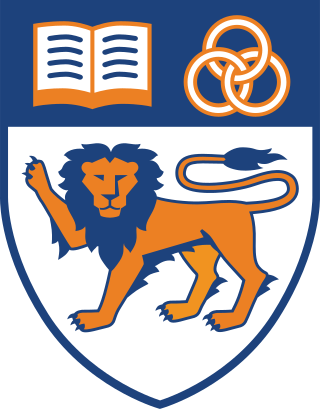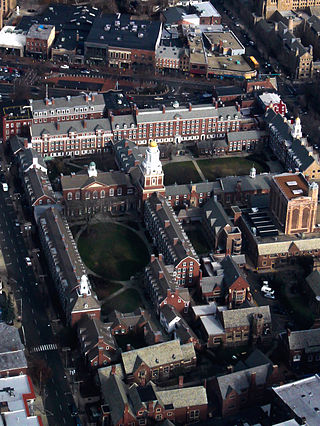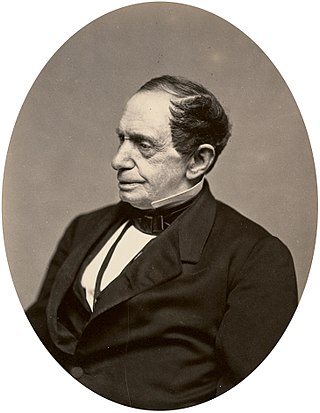
Grace Brewster Hopper was an American computer scientist, mathematician, and United States Navy rear admiral. One of the first programmers of the Harvard Mark I computer, she was a pioneer of computer programming who invented one of the first linkers. Hopper was the first to devise the theory of machine-independent programming languages, and the FLOW-MATIC programming language she created using this theory was later extended to create COBOL, an early high-level programming language still in use today.

Yale University is a private Ivy League research university in New Haven, Connecticut. Founded in 1701, Yale is the third-oldest institution of higher education in the United States and one of the nine colonial colleges chartered before the American Revolution.

John Caldwell Calhoun was an American statesman and political theorist from South Carolina who held many important positions including being the seventh vice president of the United States from 1825 to 1832. He adamantly defended slavery and sought to protect the interests of the white South. He began his political career as a nationalist, modernizer, and proponent of a strong national government and protective tariffs. In the late 1820s, his views changed radically, and he became a leading proponent of states' rights, limited government, nullification, and opposition to high tariffs. He saw Northern acceptance of those policies as a condition of the South remaining in the Union. His beliefs and warnings heavily influenced the South's secession from the Union in 1860–1861. He was the first vice president to resign from the position, and the only one to do so until Spiro Agnew resigned in 1973.

Yale College is the undergraduate college of Yale University. Founded in 1701, it is the original school of the university. Although other Yale schools were founded as early as 1810, all of Yale was officially known as Yale College until 1887, when its schools were confederated and the institution was renamed Yale University. It is ranked as one of the top colleges in the United States.

The National University of Singapore (NUS) is a national public research university in Singapore. Founded in 1905 as the Straits Settlements and Federated Malay States Government Medical School, NUS is the oldest autonomous university in the country. It offers degree programmes in a wide range of disciplines at both the undergraduate and postgraduate levels, including in the sciences, medicine and dentistry, design and environment, law, arts and social sciences, engineering, business, computing, and music.

James William Charles Pennington was an American historican, abolitionist, orator, minister, writer, and social organizer active globally. Pennington is the first known Black student to attend Yale University. He was ordained as a minister in the Congregational Church, later also serving in Presbyterian churches for congregations in Hartford, Connecticut; and New York. After the Civil War, he served congregations in Natchez, Mississippi; Portland, Maine; and Jacksonville, Florida.

Trumbull College is one of fourteen undergraduate residential colleges of Yale University in New Haven, Connecticut. The college is named for Jonathan Trumbull, governor of Connecticut from 1769 to 1784 and advisor and friend to General George Washington. A Harvard College graduate, Trumbull was the only colonial governor to support the American Revolution.

Yale Divinity School (YDS) is one of the twelve graduate and professional schools of Yale University in New Haven, Connecticut.
Charles Bartlett Johnson is an American billionaire businessman, with an estimated current net worth of around $6.1 billion.

The Yale School of Engineering & Applied Science is the engineering school of Yale University. When the first professor of civil engineering was hired in 1852, a Yale School of Engineering was established within the Yale Scientific School, and in 1932 the engineering faculty organized as a separate, constituent school of the university. The school currently offers undergraduate and graduate classes and degrees in electrical engineering, chemical engineering, computer science, applied physics, environmental engineering, biomedical engineering, and mechanical engineering and materials science.
Peter Salovey is an American social psychologist and current president of Yale University. He previously served as Yale's provost, dean of Yale Graduate School of Arts and Sciences, and dean of Yale College. Salovey is one of the early pioneers in emotional intelligence.
Anthony Townsend Kronman is a Sterling Professor at Yale Law School specializing in contracts, bankruptcy, jurisprudence, social theory, and professional responsibility. He was the dean of Yale Law School from 1994 to 2004.

Yale University has a system of fourteen residential colleges with which all Yale undergraduate students and many faculty are affiliated. Inaugurated in 1933, the college system is considered the defining feature of undergraduate life at Yale College, and the residential colleges serve as the residence halls and social hubs for most undergraduates. Construction and programming for eight of the original ten colleges were funded by educational philanthropist Edward S. Harkness. Yale was, along with Harvard, one of the first universities in the United States to establish a residential college system.

Yale-NUS College is a liberal arts college in Singapore. Established in 2011 as a collaboration between Yale University and the National University of Singapore, it is the first liberal arts college in Singapore and one of the first few in Asia. With an average acceptance rate of 5.2%, it is among the most selective institutions in the world. Yale-NUS was the first institution outside New Haven, Connecticut that Yale University had developed in its 300-year history, making Yale the first American Ivy League school to establish a college bearing its name in Asia.

Jonathan Scott Holloway is an American historian and academic administrator who is the 21st president of Rutgers, The State University of New Jersey.

Benjamin Franklin College is a residential college for undergraduates of Yale College in New Haven, Connecticut. It opened to students for the 2017 academic year.

Pauli Murray College is a residential college for undergraduates of Yale College in New Haven, Connecticut. The college, which opened to students in fall of 2017, was designed by Robert A. M. Stern Architects. It is named for Pauli Murray, an American civil and women's rights activist, Christian minister, and a 1965 graduate of Yale Law School.
Colleton Preparatory Academy is a pre-kindergarten to 12th grade school in Walterboro, South Carolina, United States.

The role of slavery at American colleges and universities has been a focus of historical investigation and controversy. Enslaved Africans labored to build institutions of higher learning in the United States, and the slave economy was involved in funding many universities. People, forced to labor and seen as less than human, were used to build academic buildings and residential halls. Though slavery has long been presented as a uniquely Southern institution, colleges and universities in Northern states benefited from the labor of slaves. The economics of slavery brought some slave owners great wealth, enabling them to become major donors to fledgling colleges. Many colleges founded in states with legalized slavery utilized enslaved people and benefited from the slavocracy. Slaves were also sold by university administrators to generate capital. In some parts of the nation it was also not uncommon for wealthy students to bring an enslaved person with them to college. Ending almost 250 years of slavocracy did not end white supremacy, structural racism, or other forms of oppression at American colleges and the legacy of slavery still persists in many establishments.






















